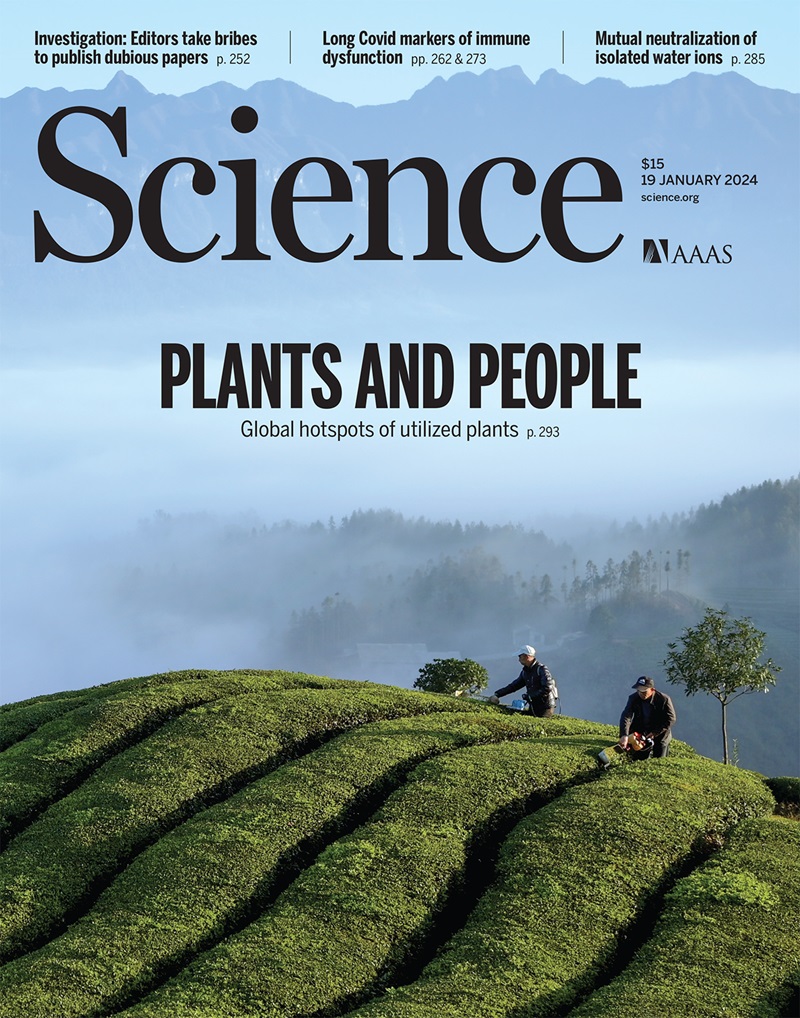TIGR-Tas: A family of modular RNA-guided DNA-targeting systems in prokaryotes and their viruses
IF 45.8
1区 综合性期刊
Q1 MULTIDISCIPLINARY SCIENCES
引用次数: 0
Abstract
RNA-guided systems provide remarkable versatility, enabling diverse biological functions. Through iterative structural and sequence homology-based mining starting with a guide RNA-interaction domain of Cas9, we identified a family of RNA-guided DNA-targeting proteins in phage and parasitic bacteria. Each system consists of a tandem interspaced guide RNA (TIGR) array and a TIGR-associated (Tas) protein containing a nucleolar protein (Nop) domain, sometimes fused to HNH (TasH)– or RuvC (TasR)–nuclease domains. We show that TIGR arrays are processed into 36-nucleotide RNAs (tigRNAs) that direct sequence-specific DNA binding through a tandem-spacer targeting mechanism. TasR can be reprogrammed for precise DNA cleavage, including in human cells. The structure of TasR reveals striking similarities to box C/D small nucleolar ribonucleoproteins and IS110 RNA-guided transposases, providing insights into the evolution of diverse RNA-guided systems.

TIGR-Tas:原核生物及其病毒中模块化rna引导的dna靶向系统家族。
rna引导系统提供了显著的多功能性,实现了多种生物功能。从Cas9的引导rna相互作用域开始,通过迭代的结构和序列同源性挖掘,我们在噬菌体和寄生细菌中鉴定了一个rna引导的dna靶向蛋白家族。每个系统由串联间隔引导RNA (TIGR)阵列和含有Nop结构域的TIGR相关(Tas)蛋白组成,有时融合到HNH (TasH)或RuvC (TasR)核酸酶结构域。我们发现TIGR阵列被加工成36-nt rna (tigRNAs),通过串联间隔器靶向机制直接序列特异性DNA结合。TasR可以被重新编程以进行精确的DNA切割,包括在人类细胞中。TasR的结构显示出与盒C/D snoRNPs和IS110 rna引导转座的惊人相似性,为了解各种rna引导系统的进化提供了见解。
本文章由计算机程序翻译,如有差异,请以英文原文为准。
求助全文
约1分钟内获得全文
求助全文
来源期刊

Science
综合性期刊-综合性期刊
CiteScore
61.10
自引率
0.90%
发文量
0
审稿时长
2.1 months
期刊介绍:
Science is a leading outlet for scientific news, commentary, and cutting-edge research. Through its print and online incarnations, Science reaches an estimated worldwide readership of more than one million. Science’s authorship is global too, and its articles consistently rank among the world's most cited research.
Science serves as a forum for discussion of important issues related to the advancement of science by publishing material on which a consensus has been reached as well as including the presentation of minority or conflicting points of view. Accordingly, all articles published in Science—including editorials, news and comment, and book reviews—are signed and reflect the individual views of the authors and not official points of view adopted by AAAS or the institutions with which the authors are affiliated.
Science seeks to publish those papers that are most influential in their fields or across fields and that will significantly advance scientific understanding. Selected papers should present novel and broadly important data, syntheses, or concepts. They should merit recognition by the wider scientific community and general public provided by publication in Science, beyond that provided by specialty journals. Science welcomes submissions from all fields of science and from any source. The editors are committed to the prompt evaluation and publication of submitted papers while upholding high standards that support reproducibility of published research. Science is published weekly; selected papers are published online ahead of print.
 求助内容:
求助内容: 应助结果提醒方式:
应助结果提醒方式:


